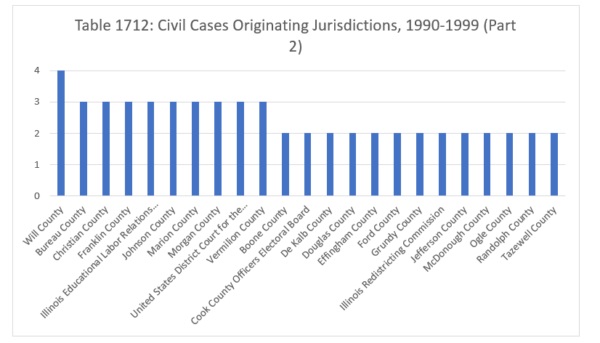This week, we're looking at where the Supreme Court's cases originate. This is important for the same reason that tracking which Districts and Divisions of the Appellate Court the Court is taking its cases from. Just as it's possible for the Court to conclude that a particular part of the Appellate Court is out of step with its views, it's equally possible for the Court to be concerned about a trial court or agency. If the Supreme Court accepts cases from the jurisdiction where you are every year, that's a good sign for the prospects of getting review. On the other hand, if the Court seldom takes cases from your jurisdiction, that tells you something about the odds of going up.
In Table 1711, we report the first half of the data. To make the chart easier to follow, we omit Cook County, which produced 253 civil cases from 1990 to 1999. Cook County has roughly five times the population of any other county in Illinois, so the disparity makes sense. Du Page County - second in population - is second in total cases. St. Clair County is third, despite ranking fifth in population, likely because of the very high reversal rate of the Fifth District. Madison County, eighth in population but also in the Fifth District, is next. Lake County, the third most populous county, is next, followed by Sangamon County, which is 11th in population, but also the home of state capitol Springfield.

We report the remainder of the data in Table 1712. In addition to the jurisdictions reported here, fifty-six jurisdictions produced one case each.

Join us back here next time as we address the criminal docket in the 1990s.
Image courtesy of Flickr by Teemu008 (no changes).
The content of this article is intended to provide a general guide to the subject matter. Specialist advice should be sought about your specific circumstances.
